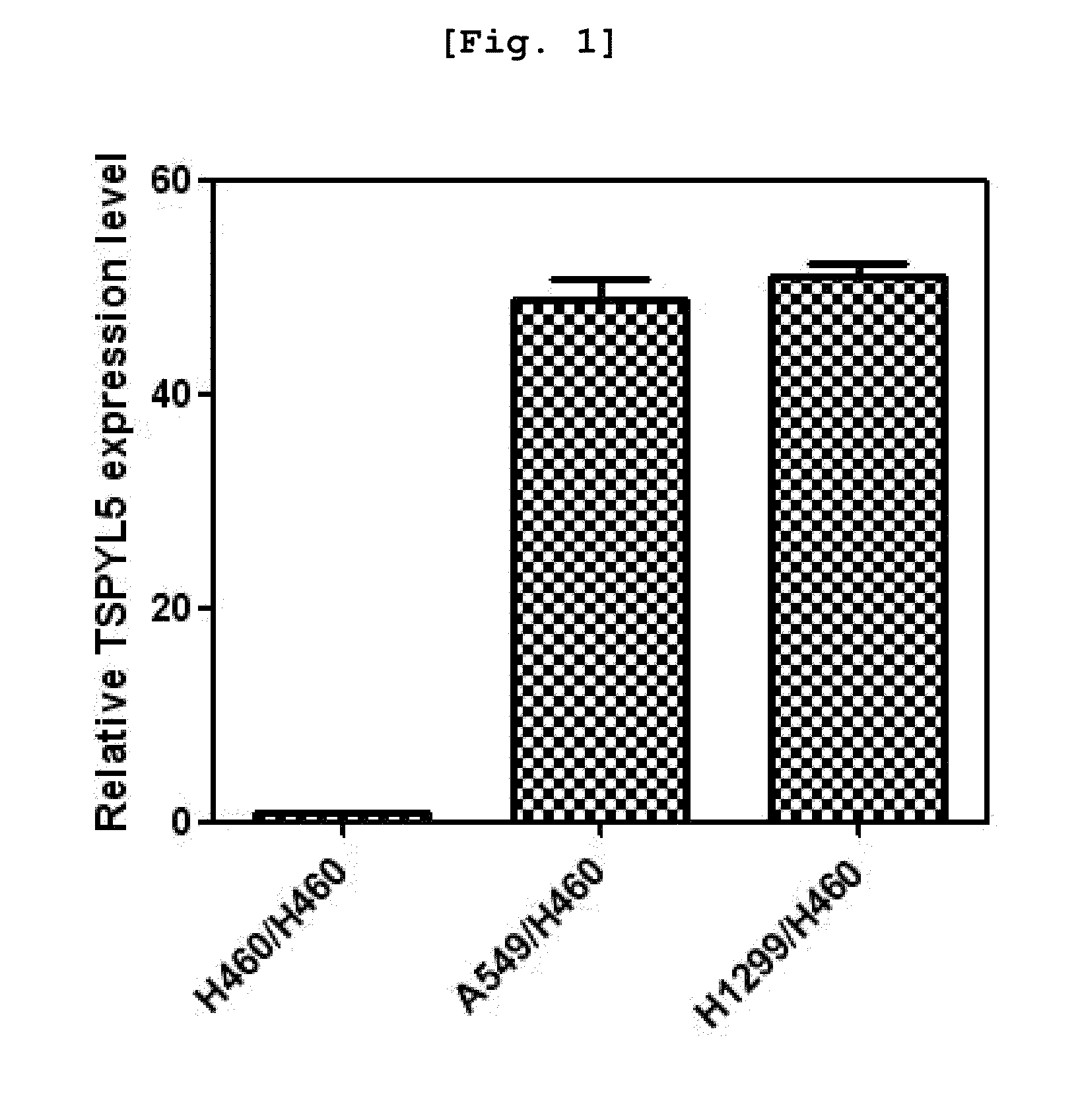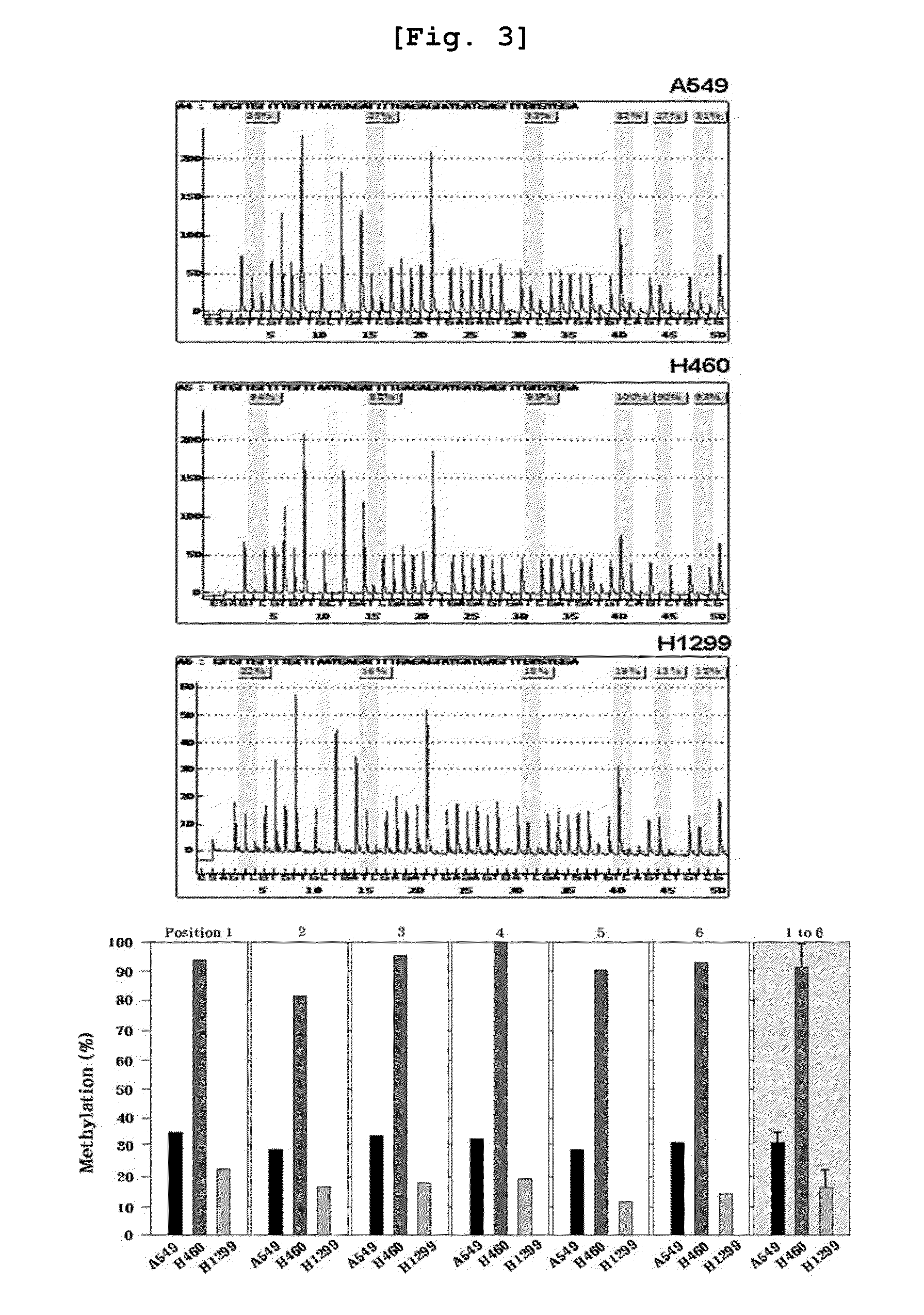Method for enhancing chemical sensitivity or radiosensitivity of cancer cells by inhibiting expression of tspyl5
a technology of tspyl5 and inhibition, which is applied in the field of enhancing the chemical sensitivity or radiosensitivity of cancer cells by inhibiting, can solve the problems that the cellular physiological functions of the tspyl5 gene have not been well known, and achieve the effect of enhancing the apoptotic effect of cancer cells and enhancing the sensitivity of cancer cells to compounds
- Summary
- Abstract
- Description
- Claims
- Application Information
AI Technical Summary
Benefits of technology
Problems solved by technology
Method used
Image
Examples
example 1
Confirmation of Expression Level of the TSPYL5 Gene in Lung Cancer Cell
[0070] Confirmation of Expression Level of the TSPYL5 Gene in a Lung Cancer Cell Line by Microarray
[0071]In order to compare the expression levels of TSPYL5 in lung cancer cell lines A549, H460, and H1299 obtained from Korean Cell Line Bank, Cancer Research Center and Cancer Research Institute, Seoul National University of Medicine, microarray was performed by a method well known to those skilled in the art.
[0072]As illustrated in FIG. 1, the results show that the expression levels of TSPYL5 in the A549 and H1299 cell lines with resistance to anticancer agents and radiation were increased more than that in the non small cell lung cancer cell line H460 with sensitivity to anticancer agents and radiation by about 50 times (FIG. 1).
[0073] Confirmation of Expression Level of TSPYL5 in Lung Cancer Cell Line Through Reverse Transcription Polymerase Chain Reaction (RT-PCR)
[0074]In order to compare the expression levels ...
example 2
Quantitative Analysis of TSPYL5 Methylation Using Pyrosequencing
[0076]In order to confirm the methylation status of CpG islands in the promoter region present in TSPYL5, pyrosequencing was performed on each promoter of the TSPYL5 gene in lung cancer cell lines H460, A549, and H1299. In order to convert unmethylated cytosine to uracil by using bisulfite, total genomic DNA was isolated from each of H460, A549, and H1299 and the bisulfite was treated by using an EZ DNA methylation-Gold kit (Zymo Research, USA) to 200 ng of the genomic DNA. If DNA was treated with bisulfite, unmethylated cytosine was converted to uracil, while methylated cytosine was maintained without modification. Pyrosequencing was performed by eluting the bisulfite-treated DNA with 20 μl of sterile distilled water. 20 ng of bisulfite-treated genomic DNA was amplified by PCR. For PCR primer, a forward primer: 5′-TTAGAAAATAGGTGATGGGGGATA-3′ represented by SEQ ID No: 5 and a reverse primer: 5′-Biotin-AAATACTACCATTTCATC...
example 3
Inhibition of Expression of TSPYL5 Gene in Lung Cancer Cell Lines by Using siRNA
[0081] Preparation and Transduction of TSPYL5-siRNA Duplex Oligoribonucleotides
[0082]The genetic sequence information of the siRNA for the TSPYL5 gene was submitted to Invitrogen Corp, and then 3 kinds of 25mer TSPYL5 stealth-RNAi prepared by custom service, described in the following Table 2 were used. Introduction of the siRNA into the cell was performed by using Lipofectamine RNAi MAX (Invitrogen) with 40˜80 nM of each RNAi from 2×105 cells of A549 and H1299 cells. TSPYL5-siRNA duplex oligoribonucleotides were transduced into cells in an antibiotic (penicillin-streptomycin solution (Hyclone))-free medium, subjected to reaction for 4 to 6 hours, and then incubated in a medium supplemented with 100 units / Ml of penicillin-streptomycin solution.
TABLE 2Primer sequence (5′-3′)HSS131713(RNA)-ACCACACCCAUAUUCCUUGAUGAGC(C1)(SEQ ID No: 8)HSS131713′(RNA)-GCUCAUCAAGGAAUAUGGGUGUGGU(C1)(SEQ ID No: 9)HSS131714(RNA)-A...
PUM
| Property | Measurement | Unit |
|---|---|---|
| Sensitivity | aaaaa | aaaaa |
Abstract
Description
Claims
Application Information
 Login to View More
Login to View More - R&D
- Intellectual Property
- Life Sciences
- Materials
- Tech Scout
- Unparalleled Data Quality
- Higher Quality Content
- 60% Fewer Hallucinations
Browse by: Latest US Patents, China's latest patents, Technical Efficacy Thesaurus, Application Domain, Technology Topic, Popular Technical Reports.
© 2025 PatSnap. All rights reserved.Legal|Privacy policy|Modern Slavery Act Transparency Statement|Sitemap|About US| Contact US: help@patsnap.com



